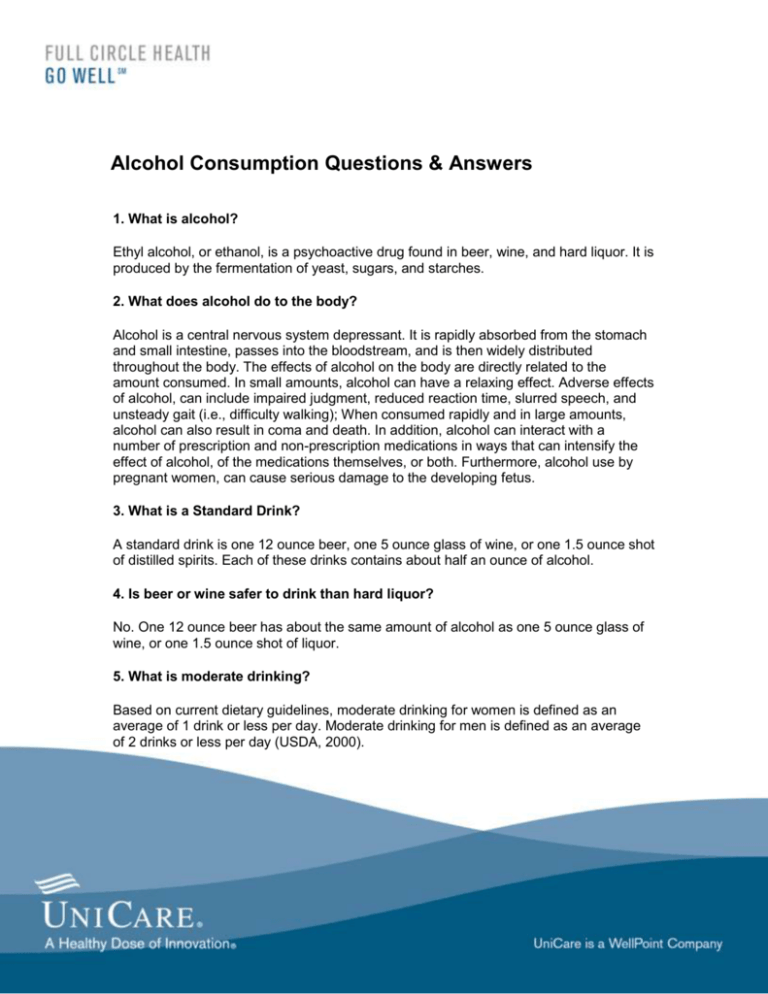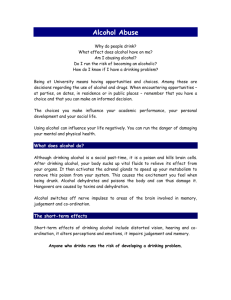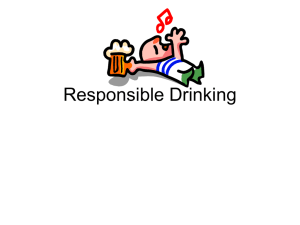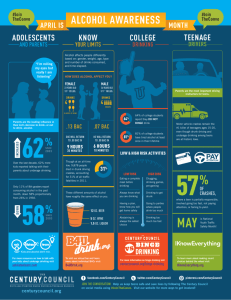Alcohol Q&A
advertisement

Alcohol Consumption Questions & Answers 1. What is alcohol? Ethyl alcohol, or ethanol, is a psychoactive drug found in beer, wine, and hard liquor. It is produced by the fermentation of yeast, sugars, and starches. 2. What does alcohol do to the body? Alcohol is a central nervous system depressant. It is rapidly absorbed from the stomach and small intestine, passes into the bloodstream, and is then widely distributed throughout the body. The effects of alcohol on the body are directly related to the amount consumed. In small amounts, alcohol can have a relaxing effect. Adverse effects of alcohol, can include impaired judgment, reduced reaction time, slurred speech, and unsteady gait (i.e., difficulty walking); When consumed rapidly and in large amounts, alcohol can also result in coma and death. In addition, alcohol can interact with a number of prescription and non-prescription medications in ways that can intensify the effect of alcohol, of the medications themselves, or both. Furthermore, alcohol use by pregnant women, can cause serious damage to the developing fetus. 3. What is a Standard Drink? A standard drink is one 12 ounce beer, one 5 ounce glass of wine, or one 1.5 ounce shot of distilled spirits. Each of these drinks contains about half an ounce of alcohol. 4. Is beer or wine safer to drink than hard liquor? No. One 12 ounce beer has about the same amount of alcohol as one 5 ounce glass of wine, or one 1.5 ounce shot of liquor. 5. What is moderate drinking? Based on current dietary guidelines, moderate drinking for women is defined as an average of 1 drink or less per day. Moderate drinking for men is defined as an average of 2 drinks or less per day (USDA, 2000). 6. What is heavy drinking? Heavy drinking is consuming alcohol in excess of 1 drink per day on average for women and greater than 2 drinks per day on average for men (NIAAA, 2004). 7. What is binge drinking? Binge drinking is generally defined as having 5 or more drinks on one occasion, meaning in a row or within a short period of time (Naimi, 2003). However, among women, binge drinking is often defined as having 4 or more drinks on one occasion (NIAAA, 2004) (Wechsler, 1998). This lower cut-point is used for women because women are generally of smaller stature than men, and absorb and metabolize alcohol differently than men do. 8. What is alcoholism? Alcoholism is a primary, chronic disease with genetic, psychosocial, and environmental factors influencing its development and manifestations. The disease is often progressive and fatal. It is characterized by continuous or periodic: impaired control over drinking, preoccupation with the drug alcohol, use of alcohol use despite adverse consequences, and distortions in thinking, most notably denial (ASAM, 2001). 9. What is alcohol abuse? Alcohol abuse is characterized by recurrent alcohol-related problems, including problems with relationships, job performance, or both; the use of alcohol in hazardous situations (e.g., while driving a car); or some combination of these (DSM IV, 1994). 10. Why are some people more sensitive to alcohol than others? Individual reactions to alcohol can vary greatly, and may be influenced by many factors, including age, gender, race, ethnicity, physical condition, the amount of food eaten before drinking, the use of drugs or medicines, family history of alcohol problems, and many other factors as well. Therefore, while drinking guidelines and definitions of drinking patterns can be very helpful in identifying risky patterns of alcohol use, personal decisions about whether to drink, and if so, when and how much, should take into account these individual factors as well. 11. What does it mean to drink too much? A person may be said to be “drinking too much” or engaging in “excessive drinking” if they exceed either the guidelines for daily alcohol consumption, or the guidelines for average daily alcohol consumption. Among men, excessive drinking may be defined as more than 4 drinks per day, or an average of more than 2 drinks per day over a 7 or 30 day period. Among women, excessive drinking may be defined as more than 3 drinks per day, or an average of more than 1 drink per day over a 7- or 30- day period (NIAAA, 2004). However, current guidelines specify that certain individuals (e.g., youth under age 21 years, pregnant women, and persons recovering from alcoholism) should not drink at all. Among these individuals, any alcohol consumption may be too much. In addition, anyone who chooses to drink should be aware that individual reactions to alcohol can vary greatly. Therefore, when in doubt about whether it’s appropriate to drink, and if so, how much, it is always best to consult one’s own personal physician. 12. What does it mean to get drunk? Drunkenness or alcohol intoxication is caused by an overdose of alcohol. However, the number of drinks that an individual needs to consume to get drunk varies based on a number of factors, including age, gender, physical condition, and the amount of food eaten before drinking, the use of drugs or medicines, and many other factors. However, binge drinking (i.e., for a man, consuming 5 or more drinks per occasion, and for a woman, consuming 4 or more drinks per occasion) typically results in intoxication. 13. What does it mean to be above the legal limit for drinking? The “legal limit for drinking” is the alcohol level above which an individual is subject to legal penalties (e.g., loss of a driver's license). Typically, this alcohol level is measured in blood or breath, using either a blood alcohol test or a breathalyzer, respectively. Legal limits are defined by a government entity (e.g., state legislature or regulatory agency), and are specific to the situation that a person is in (e.g., driving a car) as well as the characteristics of the person themselves (e.g., their age). For example, in most states, the current legal limit for operating a motor vehicle is 0.08%, or 80 mg/dL among drivers who are age 21 years or older. However, there is zero tolerance for drivers who are under age 21 years, meaning that they are not allowed to operate a motor vehicle with any alcohol in their system. In contrast, the legal limit is 0.04% or 40 mg/dL for commercial truck drivers. Different legal limits also apply to airline pilots, bus drivers, and to persons operating recreational watercraft. However, it is important to recognize that the legal limit does not define a level below which it is safe to operate a vehicle or engage in some other activity rather, the legal limit is intended to define a level at or above which an individual is subject to legal action under a specific set of circumstances. Therefore, decisions about the appropriate level of alcohol consumption in a particular situation should begin with a careful assessment of whether it’s appropriate to be drinking at all. 14. What are common health effects of drinking too much? Excessive drinking, including binge and heavy drinking, has numerous chronic (longterm) and acute (short-term) health effects. Chronic health consequences of excessive drinking can include liver cirrhosis (damage to liver cells); pancreatitis (inflammation of the pancreas); various cancers, including cancer of the liver, mouth, throat, larynx (the voice box), and esophagus; high blood pressure; and psychological disorders. Acute health consequences of excessive drinking can include motor vehicle injuries, falls, domestic violence, rape, and child abuse (Naimi, 2003). 15. How do I know if it’s ok to drink? The current Dietary Guidelines for Americans recommends that if you choose to drink alcoholic beverages, you do so in moderation (see definition of moderate drinking). However, these guidelines also specify that there are some people who should not drink alcoholic beverages at all. These people include: Children and adolescents. Individuals of any age who cannot restrict their drinking to moderate levels. Women who may become pregnant or who are pregnant. Individuals who plan to drive, operate machinery, or take part in other activities that requires attention, skill, or coordination. Individuals taking prescription or over-the-counter medications that can interact with alcohol. Therefore, when in doubt about whether it’s appropriate to drink, and if so, how much, it is always best to consult one’s own personal doctor. 16. How do I know if I have a drinking problem? Drinking is a problem if it causes trouble in your relationships, in school, in social activities, or in how you think and feel. If you are concerned that either you or someone in your family might have a drinking problem, it is important that you consult your personal doctor. Questionnaires and other tools can be useful to screen for drinking problems. Additional information on screening for alcohol problems may be obtained from the National Institute for Alcohol Abuse and Alcoholism (http://www.niaaa.nih.gov/publications/Practitioner HelpingPatients.htm#step1A). For more information on how alcohol and tobacco affect health, visit www.unicare.com. Source: Centers for Disease Control and Prevention - http://www.cdc.gov/alcohol/faqs.htm






